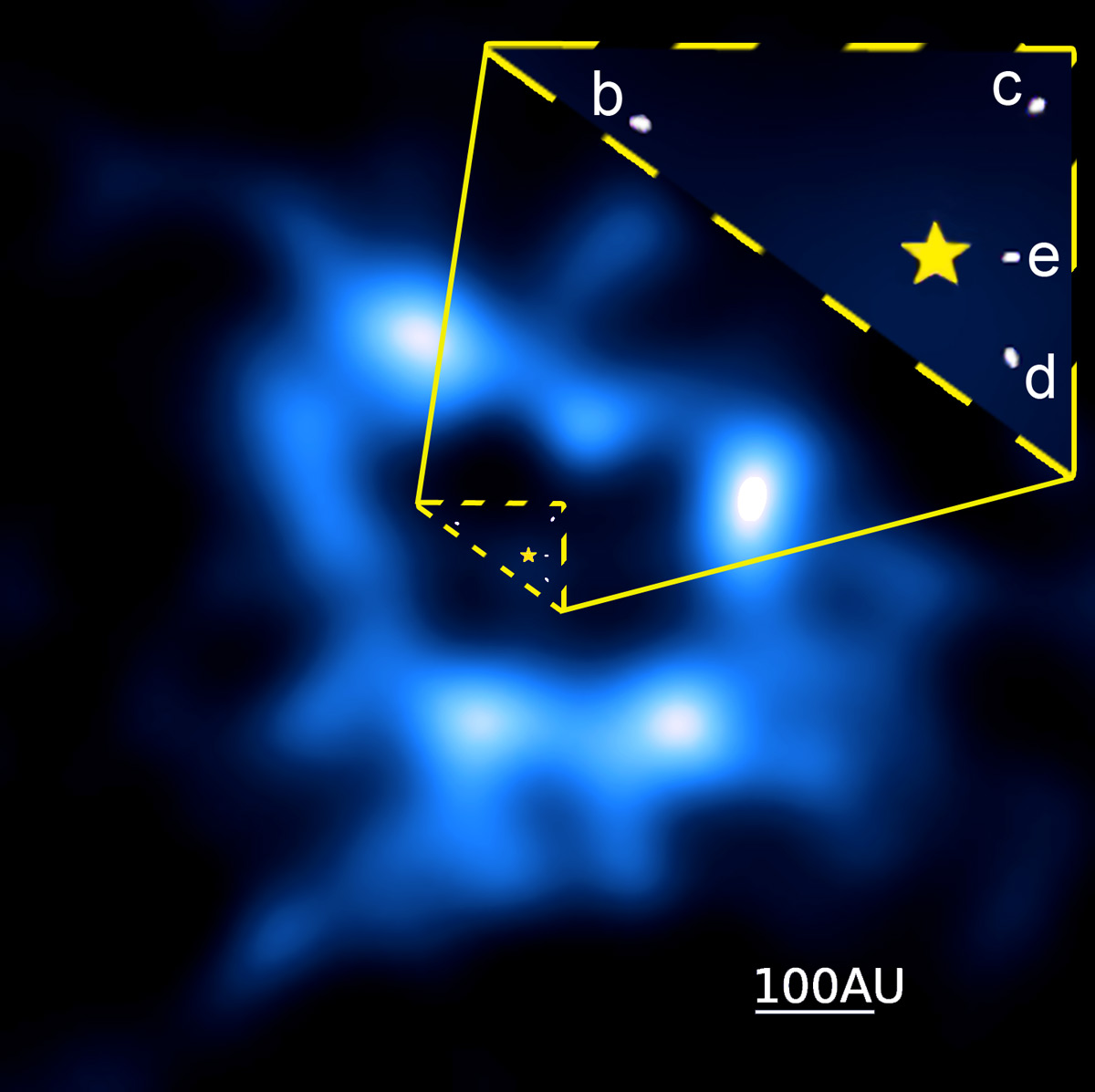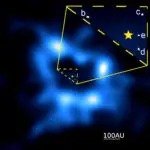Cometary Belt around Distant Multi-Planet System Hints at Hidden or Wandering Planets
Astronomers using the Atacama Large Millimeter/submillimeter Array (ALMA) have made the first high-resolution image of the cometary belt (a region analogous to our own Kuiper belt) around HR 8799, the only star where multiple planets have been imaged directly. The shape of this dusty disk, particularly its inner edge, is surprisingly inconsistent with the orbits of the planets, suggesting that either they changed position over time or there is at least one more planet in the system yet to be discovered.
"This data really allow us to see the inner edge of this disk for the first time," explains Mark Booth from Pontificia Universidad Católica de Chile and lead author of the study. "By studying the interactions between the planets and the disk, this new observation shows that either the planets that we see have had different orbits in the past or there is at least one more planet in the system that is too small to have been detected."
The disk, which fills a region 150 to 420 times the Sun-Earth distance, is produced by the ongoing collisions of cometary bodies in the outer reaches of this star system. ALMA was able to image the emission from millimeter-size debris in the disk; according to the researchers, the small size of these dust grains suggests that the planets in the system are larger than Jupiter. Previous observations with other telescopes at shorter wavelengths did not detect this discrepancy in the disk. It is not clear if this difference is due to the low resolution of the previous observations or because different wavelengths are sensitive to different grain sizes, which would be distributed slightly differently.

ALMA image of dusty cometary ring around HR 8799, the only star where multiple planets have been imaged. The new data suggest the planets either migrated or another undiscovered planet is present. The zoom-in portion of the image, taken with ESO's Very Large Telescope, shows the location of the known planets in this system in relation to a graphical representation of the central star. Credit: Booth et al., ALMA (NRAO/ESO/NAOJ); A. Zurlo, et al
HR 8799 is a young star approximately 1.5 times the mass of the Sun located 129 light-years from Earth in the direction of the constellation Pegasus.
"This is the very first time that a multi-planet system with orbiting dust is imaged, allowing for direct comparison with the formation and dynamics of our own Solar System," explains Antonio Hales, co-author of the study from the National Radio Astronomy Observatory in Charlottesville, Virginia.
Additional information
These results were published in the Monthly Notices of the Royal Astronomical Society titled "Resolving the Planetesimal Belt of HR 8799 with ALMA" by Booth et al., May 2016.
Preprint: https://arxiv.org/abs/1603.04853
The research team was composed by Mark Booth ([1], [2]), Andrés Jordán ([1], [3]), Simón Casassus ([2], [4]), Antonio S. Hales ([5], [6]), William R. F. Dent ([5]), Virginie Faramaz ([1]), Luca Matrà ([7],[8]), Denis Barkats ([9]), Rafael Brahm ([1], [3]) Jorge Cuadra ([1], [2]).
[1] Instituto de Astrofísica, Pontificia Universidad Católica de Chile, Vicuña Mackenna 4860, Santiago, Chile
[2] Millennium Nucleus “Protoplanetary Disks”
[3] Millennium Institute of Astrophysics, Vicuña Mackenna 4860, Santiago, Chile
[4] Departamento de Astronomía, Universidad de Chile, Casilla 36-D, Santiago, Chile
[5] Joint ALMA Observatory, Alonso de Córdova 3107, Vitacura 763-0355, Santiago, Chile
[6] National Radio Astronomy Observatory, 520 Edgemont Road, Charlottesville, Virginia, 22903-2475, USA
[7] Institute of Astronomy, University of Cambridge, Madingley Road, Cambridge CB3 0HA, UK
[8] European Southern Observatory, Alonso de Córdova 3107, Vitacura, Casilla 19001, Santiago, Chile
[9] Harvard University, 60 Garden Street, Cambridge, MA 02138, USA
The Atacama Large Millimeter/submillimeter Array (ALMA), an international astronomy facility, is a partnership of the European Organisation for Astronomical Research in the Southern Hemisphere (ESO), the U.S. National Science Foundation (NSF) and the National Institutes of Natural Sciences (NINS) of Japan in cooperation with the Republic of Chile. ALMA is funded by ESO on behalf of its Member States, by NSF in cooperation with the National Research Council of Canada (NRC) and the Ministry of Science and Technology (MOST) in Taiwan and by NINS in cooperation with the Academia Sinica (AS) in Taiwan and the Korea Astronomy and Space Science Institute (KASI).
ALMA construction and operations are led by ESO on behalf of its Member States; by the National Radio Astronomy Observatory (NRAO), managed by Associated Universities, Inc. (AUI), on behalf of North America; and by the National Astronomical Observatory of Japan (NAOJ) on behalf of East Asia. The Joint ALMA Observatory (JAO) provides the unified leadership and management of the construction, commissioning and operation of ALMA.
Contacts
-
Valeria Foncea
Education and Public Outreach ManagerJoint ALMA Observatory Santiago - ChilePhone: +56 2 2467 6258Cel: +56 9 7587 1963Email: [email protected] -
Charles E. Blue
Public Information OfficerNational Radio Astronomy Observatory Charlottesville, Virginia - USAPhone: +1 434 296 0314Cel: +1 202 236 6324Email: [email protected] -
Richard Hook
Public Information Officer, ESOGarching bei München, GermanyPhone: +49 89 3200 6655Cel: +49 151 1537 3591Email: [email protected] -
Masaaki Hiramatsu
Education and Public Outreach Officer, NAOJ Chile

